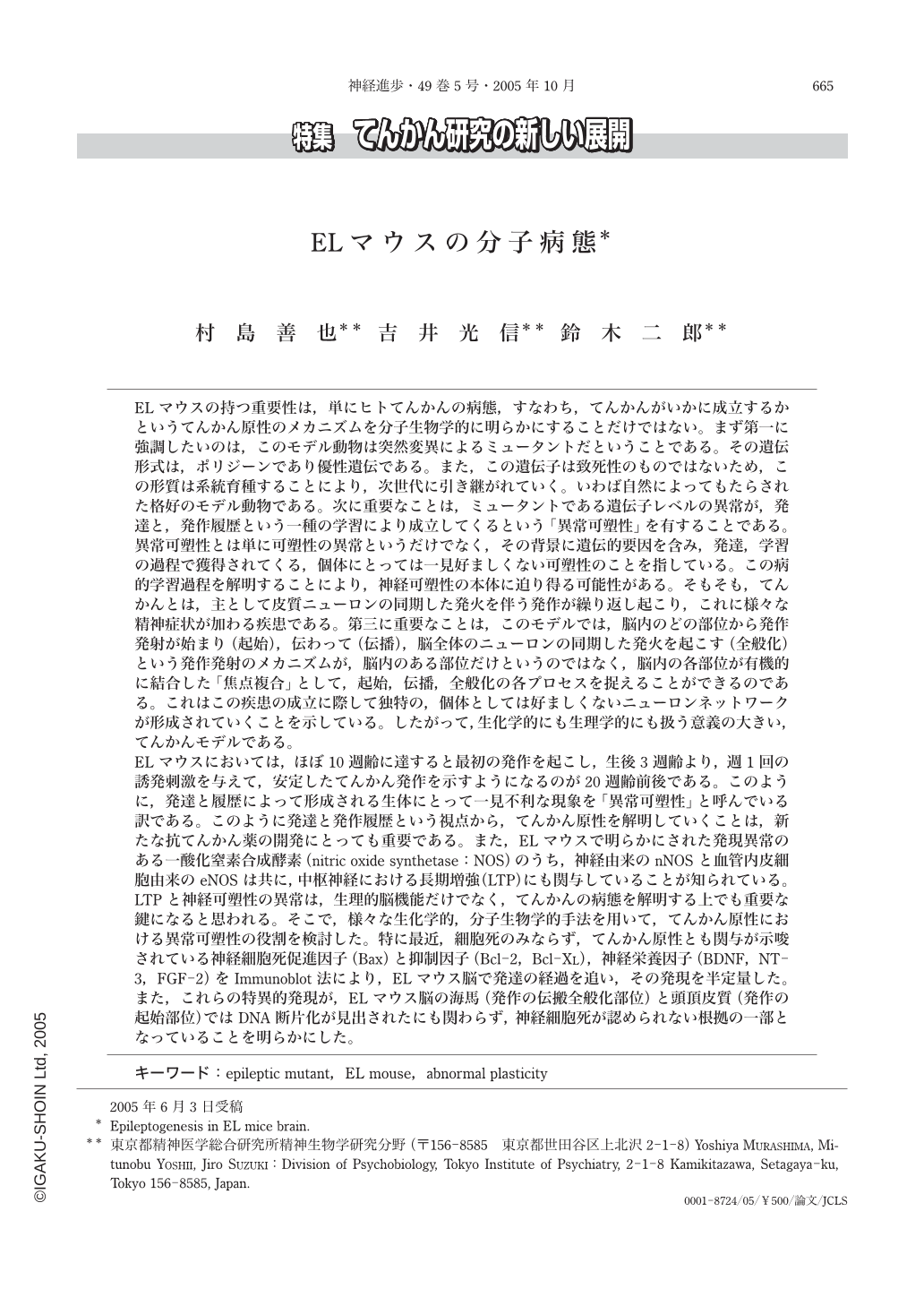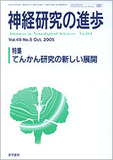Japanese
English
- 有料閲覧
- Abstract 文献概要
- 1ページ目 Look Inside
ELマウスの持つ重要性は,単にヒトてんかんの病態,すなわち,てんかんがいかに成立するかというてんかん原性のメカニズムを分子生物学的に明らかにすることだけではない。まず第一に強調したいのは,このモデル動物は突然変異によるミュータントだということである。その遺伝形式は,ポリジーンであり優性遺伝である。また,この遺伝子は致死性のものではないため,この形質は系統育種することにより,次世代に引き継がれていく。いわば自然によってもたらされた格好のモデル動物である。次に重要なことは,ミュータントである遺伝子レベルの異常が,発達と,発作履歴という一種の学習により成立してくるという「異常可塑性」を有することである。異常可塑性とは単に可塑性の異常というだけでなく,その背景に遺伝的要因を含み,発達,学習の過程で獲得されてくる,個体にとっては一見好ましくない可塑性のことを指している。この病的学習過程を解明することにより,神経可塑性の本体に迫り得る可能性がある。そもそも,てんかんとは,主として皮質ニューロンの同期した発火を伴う発作が繰り返し起こり,これに様々な精神症状が加わる疾患である。第三に重要なことは,このモデルでは,脳内のどの部位から発作発射が始まり(起始),伝わって(伝播),脳全体のニューロンの同期した発火を起こす(全般化)という発作発射のメカニズムが,脳内のある部位だけというのではなく,脳内の各部位が有機的に結合した「焦点複合」として,起始,伝播,全般化の各プロセスを捉えることができるのである。これはこの疾患の成立に際して独特の,個体としては好ましくないニューロンネットワークが形成されていくことを示している。したがって,生化学的にも生理学的にも扱う意義の大きい,てんかんモデルである。
ELマウスにおいては,ほぼ10週齢に達すると最初の発作を起こし,生後3週齢より,週1回の誘発刺激を与えて,安定したてんかん発作を示すようになるのが20週齢前後である。このように,発達と履歴によって形成される生体にとって一見不利な現象を「異常可塑性」と呼んでいる訳である。このように発達と発作履歴という視点から,てんかん原性を解明していくことは,新たな抗てんかん薬の開発にとっても重要である。また,ELマウスで明らかにされた発現異常のある一酸化窒素合成酵素(nitric oxide synthetase:NOS)のうち,神経由来のnNOSと血管内皮細胞由来のeNOSは共に,中枢神経における長期増強(LTP)にも関与していることが知られている。LTPと神経可塑性の異常は,生理的脳機能だけでなく,てんかんの病態を解明する上でも重要な鍵になると思われる。そこで,様々な生化学的,分子生物学的手法を用いて,てんかん原性における異常可塑性の役割を検討した。特に最近,細胞死のみならず,てんかん原性とも関与が示唆されている神経細胞死促進因子(Bax)と抑制因子(Bcl-2,Bcl-XL),神経栄養因子(BDNF,NT-3,FGF-2)をImmunoblot法により,ELマウス脳で発達の経過を追い,その発現を半定量した。また,これらの特異的発現が,ELマウス脳の海馬(発作の伝搬全般化部位)と頭頂皮質(発作の起始部位)ではDNA断片化が見出されたにも関わらず,神経細胞死が認められない根拠の一部となっていることを明らかにした。
In EL mice, ictogenesis has been established at around 10 weeks of age, whereas epileptogenesis will be established through experience of repetitive seizures during development. It is suggested that an“abnormal neural plasticity”may play a crucial role in the establishment of ictogenesis and epileptogenesis, and therefore, can be a potential target for the development of a new pharmacotherapy to the epilepsy. It is reported that some isoforms of nitric oxide synthetases(nNOS and eNOS)are both necessary for the establishment of long-term potentiation(LTP)phenomena. LTP and abnormal neural plasticity will play the key roles in the establishment of physiological brain function and pathogenesis of epileptic disorder.
To investigate the role of abnormal neural plasticity in the autogenesis and epileptogenesis in EL mice brain, epileptic mutant were analyzed by biochemical and molecular biological methods. And recently, antiapoptotic, proapoptotic factors and neurotrophic factors are suggested playing a role not only in the cell survival but also in the epileptogenesis. In the brain of EL, it was shown that DNA fragmentation without cell loss was observed in the parietal cortex and hippocampus, which play a key role in the seizure initiation and generalization respectively.
To investigate the role of antiapoptotic, proapoptotic factors and neurotrophic factors in the ictogenesis and epileptogenesis in EL mice brain, developmental changes of these factors are determined.

Copyright © 2005, Igaku-Shoin Ltd. All rights reserved.


